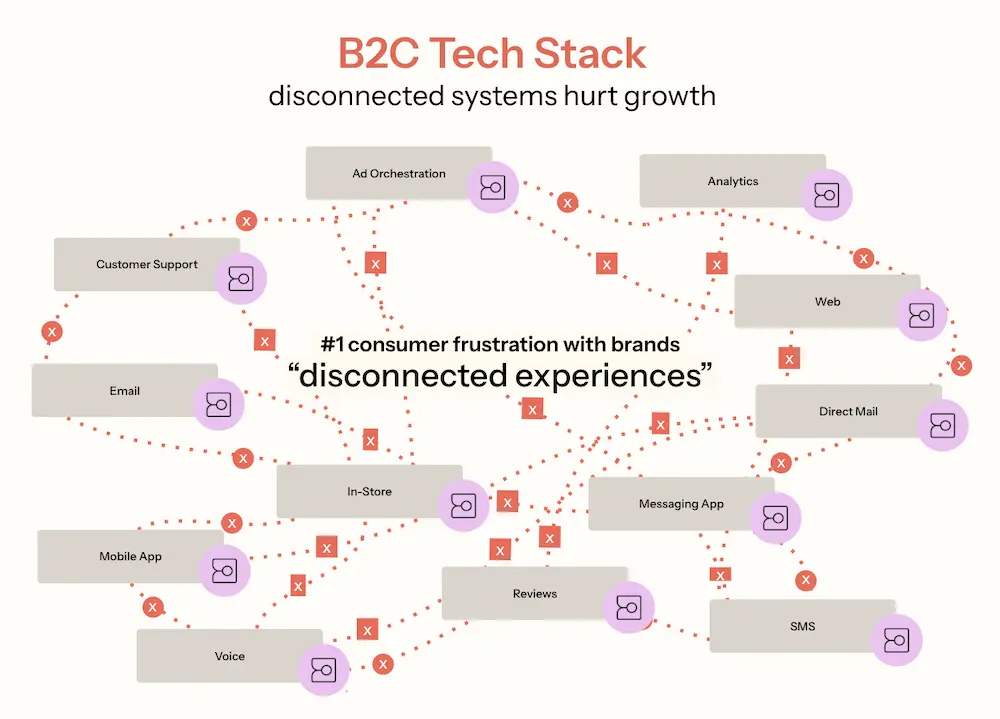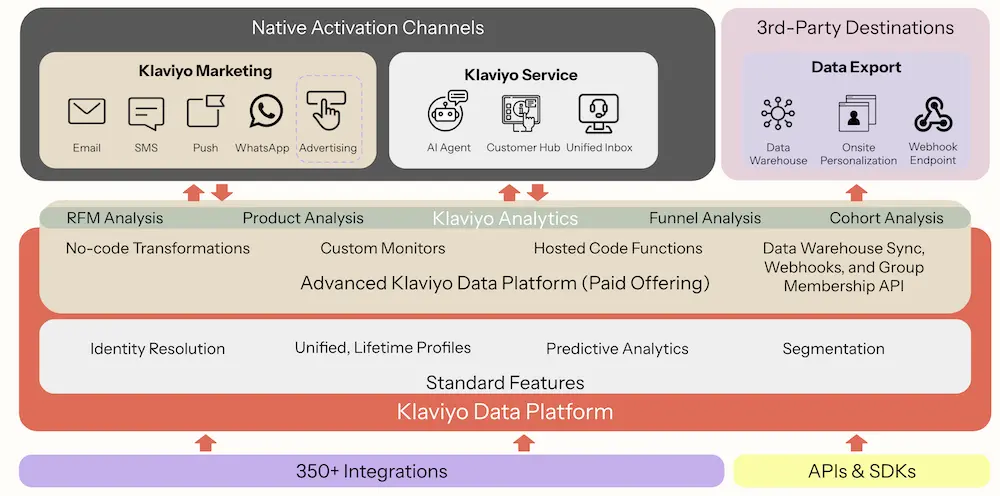Why standalone CDPs are a relic of the past—and what you should consider instead
For B2C marketers, personalisation is key to fueling growth.
Companies that excel at personalisation in marketing generate 40% more revenue from related activities than average players, according to McKinsey & Company—and while 71% of consumers expect personalization from the brands they interact with, even more (76%) get frustrated when they don’t get it.
But while 78% of ecommerce executives understand personalisation at scale is a must-have in marketing, 41% say they cannot execute all the personalised marketing tactics they deem important, Klaviyo research finds.
Why?
Because of how hard it is to wrangle data.
The unsolved challenge of personalisation at scale
Over the last 10 years, we’ve seen a dramatic acceleration in digital experiences across:
- Web
- Mobile (SMS, in-app)
- Omnichannel (POS, service, reviews)
The B2B world has long had a tool for centralising all this data: a CRM. Not so in the B2C world, where management of every channel has required a separate, dedicated tool.
This “tool sprawl” means data is fragmented. Every tool contains different pieces of information around who each customer is, but not the complete picture.

Worse, a disjointed tech stack means disjointed customer experiences. Customers can browse for products on their computer in the morning, walk into a store later that afternoon, and talk to a customer service agent about a purchase they made earlier that day. But each of those interactions lacks the context of the next, translating to missed revenue opportunities and negative customer sentiment.
B2C brands need to create a single brand experience for customers, and core to that is the idea of a centralised database—a single source of truth that can unify all these disparate pieces of information.
The promise of customer data platforms (CDPs)
Customer data platforms (CDPs) were built to solve the problem of data fragmentation.
The first iterations were homegrown systems—customer databases with custom-built data integrations. They were a pain to manage and scale.
But shortly after, productised CDP solutions like Segment and Tealium emerged into the market as options for brands to securely host and manage their customer data, either in the cloud or in their own data centres. Today, there are over 150 CDP vendors in the market.
But what exactly does a CDP do? At their core, most CDPs include a set of common capabilities:
- Identity resolution and profile unification: ability to reconcile data and tie it to customers at an individual level (critical for B2C)
- Segmentation: ability to group customers based on shared characteristics and behaviours
- Predictive analytics: ability to predict customer behaviour like propensity to purchase, lifetime value, and churn risk (previously a nice to have, but now basic essentials)
- Data integration: ability to connect data sources into the CDP and then, post-ID resolution and cleanup, sync that data back into the marketing automation and analytics tools and analytics tools in real time
- Data manipulation and transformation: ability to clean data and shape it to fit the needs of your business

With a CDP in place, B2C marketers and customer service teams would finally have access to clean and accurate data in order to deliver highly personalised experiences to their customers.
Right? Well, not quite.
Where traditional, standalone CDPs fall short
CDPs promised to unify data and solve the challenge of personalisation at scale. But for brands that have deployed CDPs, results have been mixed. According to Forrester:
- 68% of martech leaders feel their current CDP is insufficient for better marketing and analysis.
- 75% say managing their CDP is more costly in dollars and time than they originally anticipated.
- 60% say their CDP is too technically complex for their marketing and advertising teams.
- 76% agree that CDPs need to be better integrated across their organisation’s tech stack.
It’s clear that traditional, standalone CDPs have by and large failed to live up to their expectations. Here are a few reasons why:
The value of a CDP is for the marketing and customer service teams that use the data for personalisation. But because of their complexity, traditional CDPs require a data engineer or developer to implement on-site data tracking or sync profiles or segments to tools that those teams use every day—resulting in lengthy or even failed implementations.
Over time, CDPs matured with AI- and ML- powered predictive analytics capabilities like the ability to predict churn. But these insights stay locked inside traditional CDPs. Even if technical teams sync that data to the downstream systems that can put it to work, non-technical end users like marketers still don’t know how to put them into action. Consider, for example, a customer with a churn risk score of 82 on a scale of 0–100. What is a lifecycle marketer supposed to do with that? Is that customer truly at risk? If so, what action should the marketer take to prevent them from churning?
Ultimately, traditional CDPs add one more thing to manage in the stack—yet another copy of the data, which costs time and money to maintain and store. The return on CDP investments just isn’t there.
Meanwhile, as customers evaluated whether their CDPs were worth the investment, the market started moving toward consolidation and simplification. Marketing automation and analytics platforms like Klaviyo started developing CDP-like capabilities, such as:
- Identity resolution and profile unification
- Predictive analytics
- Advanced segmentation
Nowadays, you can do almost everything you’d expect from a CDP in your marketing automation platform, in addition to email and SMS marketing, in-app push notifications, and reviews. And that means businesses that are using a standalone CDP are paying for a massive overlap of functionality within their tech stack.
The future of CDP is embedded
So this brings us back to our original question: in 2025, do you still need a CDP?
The role a CDP plays in unifying data is still critical to delivering personalisation at scale. But it no longer makes sense to invest in a standalone CDP.
At Klaviyo, we believe the future of CDP is embedded.
Unlike a CDP that exists as a standalone product, an embedded CDP is built directly into another system, like Klaviyo B2C CRM. It enables businesses to collect, unify, and activate customer data without a separate CDP, streamlining workflows and reducing integration complexity.
Whereas traditional CDPs focus solely on data unification, embedded CDPs combine data storage with activation—making it easier and faster for users to deliver hyper-personalised experiences, all within their existing platform.
But don’t take our word for it. Compared to traditional CDPs, embedded CDPs offer several important benefits, according to martech leaders like you. Forrester reports that:
- 80% of martech leaders believe an embedded CDP can help increase efficiency and enable actionable marketing insights.
- 76% of martech leaders agree a fully integrated CDP can remove distance between systems and unite data across tech stacks.
- 72% of martech leaders believe an embedded CDP can help reduce costs via fewer integrations and less maintenance.
Klaviyo Data Platform goes beyond the traditional CDP
Klaviyo Data Platform (KDP) is the centralised customer database that comes built-in with Klaviyo B2C CRM. KDP unifies marketing, commerce, and service data in a single, actionable platform.

Klaviyo Data Platform goes beyond the traditional CDP in a variety of important ways. It empowers you to:
- Consolidate your tech stack. You don’t have to manage a separate, standalone CDP. Reduce your CDP licensing costs and management overhead.
- Unlock immediate value from your data. Connect your data faster with 350+ pre-built integrations and simple setup, minimising technical resources to quickly drive value.
- Create one unified customer view. Enable marketing and service teams to access a shared, real-time customer view, so you can deliver a single brand experience.
- Access lifetime customer profiles. KDP stores every data point for as long as you need it. And with a lifetime lookback window, you can create segments based on any historical data point.
- Enrich your data with AI-powered insights. Traditional CDP vendors upcharge AI, but Klaviyo AI is included out of the box. Predict churn, lifetime value, and future purchases to take proactive, impactful action when it matters.
- Act on prescriptive, helpful guidance. Tools like RFM analysis don’t just leave you with raw RFM scores. Instead, they group your customers into segments like champions, loyal, needs attention, and at-risk. Klaviyo also suggests actions to take, such as sending messages to re-engage with RFM segments.
- Speed up insight to action. With native activation channels, your data is always available to use in real time within existing marketing and service workflows, like creating an abandoned cart flow or responding to a return request via support ticket. Klaviyo also supports exporting data to third-party destinations for deeper insights and personalisation.
KDP includes a set of free, standard features such as identity resolution, profiles, predictive analytics, and segmentation. Customers can also upgrade to Advanced Klaviyo Data Platform (Advanced KDP) for access to advanced data management, the ability to export data to third-party destinations, and access to advanced insights like RFM analysis, product catalog insights, and more.
Because KDP is built on a powerful data infrastructure that centralises customer data and makes it robustly actionable for highly targeted marketing, it enables you to do more, more effectively, with the data you already have in your tech stack.

Related content

Stop wasting time debating attribution models. Learn why traditional attribution is flawed and how Klaviyo’s flexible settings help you measure true marketing impact.

Migrating to Klaviyo? Get expert insights on timing, tools, and tips to maximize your impact before Black Friday & Cyber Monday.

Learn how to use Klaviyo’s advanced CDP to drive more revenue this BFCM—from real-time personalization and enriched profiles to warehouse syncs, alerts, and custom segmentation.